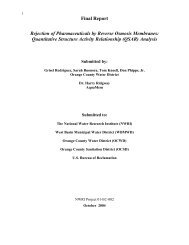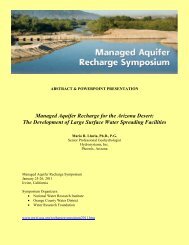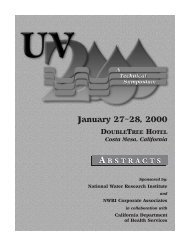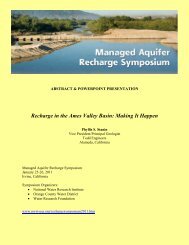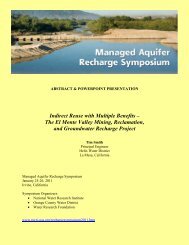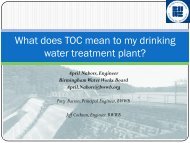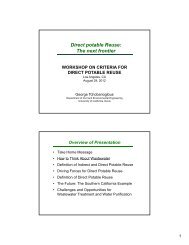RBF_Cover (for eps) - National Water Research Institute
RBF_Cover (for eps) - National Water Research Institute
RBF_Cover (for eps) - National Water Research Institute
You also want an ePaper? Increase the reach of your titles
YUMPU automatically turns print PDFs into web optimized ePapers that Google loves.
FEET<br />
1,000<br />
900<br />
800<br />
700<br />
600<br />
VERTICAL SCALE GREATLY EXAGGERATED<br />
DATUM IS SEA LEVEL<br />
Modified from Gann and others, 1973<br />
0 1 2 MILES<br />
Figure 2. Glacial valley-fill aquifer overlain by fine grained sediments in the Great Miami River Valley, Ohio<br />
(from Miller and Appel, 1997).<br />
German researchers experimented with excavating a “window” by dredging accumulated<br />
sediment. While the measure increased <strong>RBF</strong> efficiency, it was considered temporary, lasting only<br />
weeks be<strong>for</strong>e silting over (Schubert, 2000). Rivers whose flow has been altered <strong>for</strong> flood control<br />
and navigation improvement, such as the Ohio River, are particularly prone to clogging. Steep<br />
gradients and floodwaters that may have scoured the riverbed in the past have been eliminated.<br />
Wells or specially designed tunnels used to extract groundwater and bank filtrate must also be<br />
properly located to maximize system efficiency. Rivers and streams that occur with the thumbprint<br />
of the most recent continental glacial period in the United States (e.g., Wisconsin ice age) have<br />
a similar terraced profile. The unaltered modern river channel carries normal stage flows within<br />
the primary terrace. This terrace corresponds to a 100-year flood plain. Where significantly altered<br />
<strong>for</strong> flood control or navigation, the river may now have inundated the primary terrace extending<br />
from bank to bank up to the secondary terrace. The secondary terrace extends outward to the<br />
500-year flood plain. This channel was cut into the bedrock by glacially fed rivers. The rivers were<br />
large braided streams laden with sand and gravel. As the glacial outwash diminished, the scour<br />
channels filled with sand and gravel to become aquifers. The tertiary terrace is the remnant of<br />
peak stage flooding and its resultant scouring into the bedrock. Relatively thin and finer grained<br />
sediments were deposited as the flood stage fell (see Figure 2). These sediments may have <strong>for</strong>med<br />
local, relatively less-productive aquifers that are not connected to the modern river channel. The<br />
secondary terrace is the most productive place to locate <strong>RBF</strong> wells (e.g., out of main navigation,<br />
interconnected to the river, relatively thicker aquifer, greater potential <strong>for</strong> effective filtration).<br />
Potential <strong>RBF</strong> Regions<br />
Grand River<br />
B<br />
0 1 2 KILOMETERS<br />
The greatest potential <strong>for</strong> <strong>RBF</strong> — and, in fact, where <strong>RBF</strong> has been implemented — in the United<br />
States is in the Midwestern states. Figure 3 shows the location of mid- to large-sized communities<br />
in the United States that are located along rivers and on alluvial aquifers. Due to site conditions,<br />
<strong>RBF</strong> is a viable water supply option <strong>for</strong> many, but not all, communities.<br />
Midwest stream-valley aquifers in Midwestern states west of the Mississippi River are important<br />
sources of water <strong>for</strong> communities and industries (Figure 4). These aquifers are unconsolidated sand<br />
and gravel deposits that are thicker, greater in extent, and more productive in the major river<br />
valleys of the region. The stream-valley aquifers are unconfined and in direct connection to adjacent<br />
streams and rivers. Average yields from wells range from 100 to 1,000 gallons per minute, with some<br />
wells yielding over 3,000 gallons per minute (Olcott, 1992). <strong>RBF</strong> opportunities may be available<br />
Buried Valley<br />
B<br />
EXPLANATION<br />
Clay, silt, and fine-grained sand<br />
Coarse-grained sand and gravel<br />
Sand, gravel, and boulders<br />
Till<br />
Bedrock<br />
169



